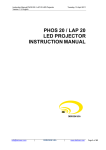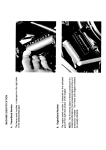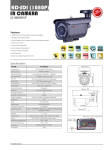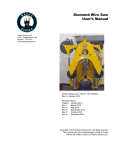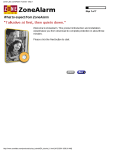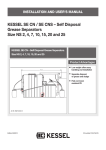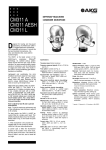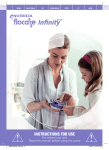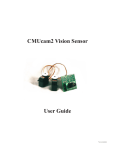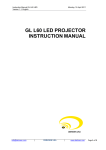Download Basic Mechanism Power Flow
Transcript
XS750 Power Flow Schematic THE BASIC MECHANISM 1-1. An Introduction to the Mechanism Power i s transmitted from the crankshaft through the clutch and two transmission shafts to a third shaft, called the middle driven gear. A splined drive cam fits inside the middle driven gear and transmits power t o the driven cam, which is located on the middle gear shaft. The drive and driven cams act as a shock damper in the drive line. These cams remain i n the same position relative to each other; that is, they do not "ratchet" or slip over when under heavy load. The middle gear case contains two geared shafts; the drive pinion (shaft and gear) and the driven pinion (gear). A flange rides on the driven pinion spline and is bolted t o the ball joint. The ball joint acts like the universal joints i n an automobile drive shaft. The ball joint is permanentl y lubricated and rarely requires replacement. The swing arm (rear arm) serves as both a suspension component and a housing for the drive shaft. Power is transmitted through the ball joint t o the drive shaft, and t o the splined gear coupling in the final gear case. In the Final Gear Case, the power is transmitted t o the Drive Pinion, through the Ring Gear, and finally to the rear wheel. NOTE: The following illustrations represent only selected components and not the actual complete assembly. Ball j o i n t I &' The main service concerns of the Middle Gear Case assembly are: (1) Gear Lash: The play between the gear teeth. This can be adjusted by shimming. (2) Tooth Patterns: The locations and patterns of contact that are made on the gear teeth. This can be adjusted by shimming. (3) Bearing Clearance: The distance between a bearing and i t s bearing housing cap. This is an extremely small clearance that must be carefully adjusted by shimming. Gear (4) Bearing Preload: The set load forcing tapered roller bearings against their races. In this case it is measured as the torsional resistance of the driven pinion bearings. I t is usually adjusted by replacing the Expansion Spacer and very carefully adjusting the torque on the special nut. 1-2. Lubrication The maintenance of proper lubrication i s the most important consideration that can be given t o the shaft drive system by the owner or service person. Almost any significant wear or failure can usually be traced t o low lubricant level, contaminated lubricant, or the wrong choice of gear oil. See Chapter 3 for specific gear oil recommendations and checking procedures. 1-3. Identification Some component assemblies, such as the Middle Gear Case assembly, may contain components of more than one type. These different types will be identified in the text as Type 1 or Type 2. Precise serial number identification of applicable machines is not available. Type Identifying Feature Middle Gear Case Housing cap Final Gear Case The application of parts of the individual types will be discussed in the appropriate section of this manual. NOTE: Type 1 Final Gear ............... See Type 1 preload specification (spacer type) Type 2 Final Gear ............... See Type 2 preload specification (expansion spacer type) SPECIAL TOOLS The following special tools are necessary for complete servicing of shaft drive components. Gear l a s h measurement tool (final gear) Gear lash measurement tool (middle gear) P.No.90890-01231 P.No.90890-01230 Middle and final gear holding tool Ring gear holding tool P.No.90890-01229 P.No. 90890-01254 Dial gauge stand Torque wrench (0 - 30 cm-kg) P.No.90890-01232 P.No.90890-05147 In addition t o these tools and common hand tools, the following are required: 1 - t o n press Universal bearing puller Feeler gauges Loctite or similar thread sealant Contact pattern paint (See Section 6-2) Bearing installation collars ft-lbs) Torque wrench 0 -~10 m-kg (0 ~ 70 ft-lb) Dial gauge The following special tools are not available but can be constructed for shaft drive component disassembly and assembly: Press Tool No. 1 For final gear guide coller removal (see page126) Final Gear Stand Press Tool No. 2 For final gear roller bearing and oil seal installation (see page 130) ROUTINE MAINTENANCE AND INSPECTION 3-1. GEAR OIL TYPE AND QUANTITY Middle Gear Oil Capacity: 375 cc (13.0 U.S. fluid oz) Final Gear Oil Capacity: 300 cc (10.0 U.S. fluid oz) * WE90 - sAEa0 0°C 5’C 10~c15°c If desired, an SAE 8OW/90 hypoid gear oil may be used for all conditions. NOTE: “GL-4” is a gear oil quality and additive rating. “GL-5” or “GL-6” designated gear oils of the proper weight may also be used. 3-2. OIL LEVEL MEASUREMENT A. Place the machine on a level surface and place it on the center stand. The engine should be cool (at atmospheric temperature). Allow 2 minutes for oil to drain to bottom of cases. B. Remove the oil filler cap. Check the oil level with level gauge (from tool kit) as shown. The correct oil level is between the two marks on each end of the level gauge. Use end of gauge marked “REAR” for measuring the rear (final) gear case. Use the end marked “MIDDLE” for measuring the middle gear case. NOTE: Middle gear and final gear oil can be checked with same level gauge, which is in the owners tool kit. 3-3. GEAR OIL REPLACEMENT NOTE: See Chapter 4 regarding the inspection of drained oil. page 110 A. Place an oil pan under the transmission for the middle gear and under the final gear case. C. Reinstall the middle and/or final drain plug(s). MIDDLE GEAR DRAIN BOLTTORQUE: 4.3 m-kg (31 ft-lb) FINAL GEAR DRAIN BOLT TORQUE: 2.3 m-kg (17 ft-lb) B. Remove the middle and/or final gear oil filler cap(s) and the drain plug(s), and drain the oil. WARNING: When draining or filling, take care not to allow foreign material to enter the middle and/or final gear case. Do not allow the gear oil to contact the tire and wheel. D. Fill the gear case(s) up to specified level. Oil Capacity: Middle Gear Case: 375 cc (13.0 U.S. fl. oz) Final Gear Case: 300 cc (10.0 U.S. fl. oz) Recommended oil: (See page 9) E. Reinstall the filler cap(s) securely. NOTE: After initial 400 km (250 mi) oil change, it is normally not necessary to change middle and final gear oil more frequently than the indicated service interval of 9,600 km (6,000 mi ). TROUBLESHOOTING 4-1. TROUBLESHOOTING CONDITIONS Basic conditions 1. A pronounced hesitation or "jerky" movement during acceleration, decelera tion, or sustained speed. (This must not be confused with engine surging or transmission characteries). 2. A "rolling rumble" noticeabte a t low Possible damaged areas A. Damage t o bearings. B. Improper gear lash; improper gear tooth contact. C. Gear tooth damage. D. Drive flange/ball joint bolts loose. speed; a high-pitched whine; a "clunk" from a shaft drive component or area. 3. A locked-up condition of the shaft drive mechanism; no power transmitted from engine t o rear wheel. E. Broken drive shaft. F. Disconnected flange/ball joint connection. G. Driven cam seized t o middle gear drive pinion shaft. H. Broken gear teeth. I. Seizure due t o lack of lubrication. J. Small foreign object lodged between moving parts. NOTE: Damage areas A, B and C above may be extremely difficult t o diagnose. The symptoms are quite subtle and difficult t o distinguish from normal machine operating noise. I f there is reason t o believe component ( s ) are damaged, remove component (s) for specific inspection. B. Consider the following Inspection Notes: (1) During coasting, accelerating or decelerating, the “rolling rumble” will increase with rear wheel speed, not engine or transmission gear speeds. However, such noise may also be due to wheel bearings. (2) Noise that varies with acceleration and deceleration: Following incorrect reassembly, a condition of too-little gear lash may produce a whine during deceleration. CAUTION: Too-little gear lash is extremely destructive to gear teeth. If a test ride following reassembly indicates this condition, stop riding immediately to minimize damage to gears. (3) A slight “thunk” must be distinguished from normal machine operation. It will be most noticeable at low speed and could indicate broken gear teeth. WARNING: If broken gear teeth are suspected, stop riding immediately. This condition could lead to locking-up of the shaft drive assembly and result in harm to a rider. (4) If the drive flange/ball joint bolts are slightly loose, a “clunk” may be felt when slowly taking off, or when changing from slow acceleration to slow deceleration. At high speed this will result in vibration. WARNING: Do not continue riding a machine suspected of having loose flange/ball joint bolts. The components may break, causing injury to a rider. C. Troubleshooting Chart Where Basic Conditions (1) and (2) above exist, consider the following Chart: Feel for wheel bearing damage. Replace wheel bearing. (See XS750D Service Manual) No r Check rear wheel (with brake caliper removed). Feel for bearing damage. Yes Remove rear wheel bearing damage. Rear wheel bearings and shaft drive No not damaged. 9 bearings probably Repeat test or remove individual components. Replace rear wheel bearing. No Remove drive shaft components. Inspect according to proper section of manual. D. Oil Leak Inspection If a shaft drive component is suspected of leaking oil, first thoroughly clean the entire machine. The apparent location of an oil leak on a dusty machine may be misleading. Dry the machine and apply a leak-localizing compound or a dry-powder spray deodorant that will limit the flow of any leaking oil. Operate the machine prepared in this way for the distance necessary to percisely locate the leak. There are the possibilities that a component housing may have been damaged by road debris or an accident, or a gasket or seal may be cracked or broken. However, on new or nearly new machines an apparent oil leak may be the result of a rust-preventive coating or excess assembly lubrication of seals. Always clean the machine and recheck the suspected location of any apparent leakage. Oil Seals and Gaskets Rubber seal (Drive shaft housing in swing arm contains no oil) O-ring E. Checking Drained Oil Whenever a problem is suspected in either the middle or final gear assemblies, drain and inspect the oil. Metal particles on the drain plug or in the oil could indicate a bearing seizure or other problem i n the component. However, a small amount of metal particles in the oil is normal. REMOVAL OF COMPONENTS 5-1. Removal of Components It is normally not necessary to remove the engine t o remove the Middle Gear Case. A. Drive Shaft Joint (1) Pull rubber boot from drive shaft coupling t o expose four (4) bolts. (2)Remove 4 coupling bolts; NOTE: Use the rear brake t o lock the drive shaft. C. Middle Gear Removal Remove seven (7) middle gear case securing bolts, Remove the meddle gear case, drive cam and spring. B. Final Gear Removal ( 1 ) Remove rear axle and left shock absorber. Remove rear wheel. See XS750D Service Manual for procedures. (2) Remove 4 nuts holding Final Drive unit t o swing arm. NOTE: Keep the Final Drive pinion bearing housing attached t o the Final Drive assembly. I t may tend to separate from the Final Gear (for Type 1 Final Gear only). (3) Remove the Final Drive Gear assembly. 1. Drive cam 2 . Sprlng D. Drive Shaft Remove drive shaft as shown. 5-2. Checking Gear Lash A. Check final drive gear lash as follows (1) Remove final drive gear case. (2) Temporarily secure bearing housing as follows (Type 1 and Type 2): Place a thickness of washer (about 1/4 inch thick) over 2 opposite bearing housing studs. Install 2 nuts on these studs and temporarily tighten the bearing housing to the final drive housing. 1 . Gear lash measurement tool (6)Mount a dial gauge against the lash measurement tool a t the scribed mark (60 mm (2.36 in) from the center of the shaft). 1. Washers (3) Place gear case in a vice or other support. (4) Remove one nut from a final drive case stud bolt. Place gear holder (Special Tool) over ring gear surface and stud bolt. Tighten holder to stud bolt with nut. (7) Use special wrench to gently rotate gear coupling back and forth. Note the lash measurement on the dial gauge. FINAL GEAR LASH 0.25 - 0.50 mm (0.010 - 0.020 in): When using the measurment tool. 0.1 - 0.2 mm (0.004-0.008 in): Actual gear lash on the final gear teeth. I. ( 5 ) Install final gear lash measurement tool on gear coupling (input side). 1 . Middle and final gear holding tool (8) Check this engagement a t 4 positions. Rotate the shaft 90° each time and repeat the gear lash check. 0.1 - 0.2 mm (0.004 - 0.008 in): Measured value and actual gear lash B. Check middle gear lash as follows ( 1 ) Support gear case in a vise by the out. put shaft flange. Install the lash measurement tool on the input shaft as shown. 1. Middle and final gear holding tool 1. Gear lash measurement tool (2) Mount a dial gauge against the lash measurement tool a t the scribed mark (34 mm (1.34 in) from the center of the shaft). (3) Hold the gear case and rotate the input shaft back and forth using the special wrench. Read the gear lash on the dial gauge. ( 4 ) Check this engagement at 4 positions. Rotate the driven pinion shaft 90° each time and repeat the gear lash check.















